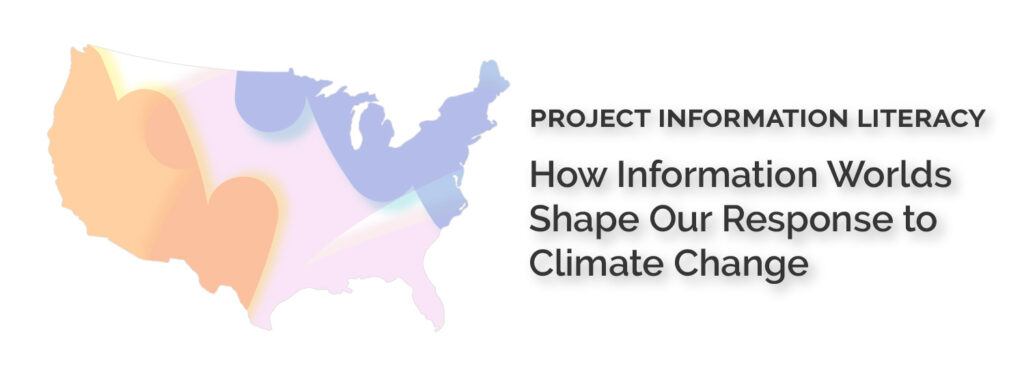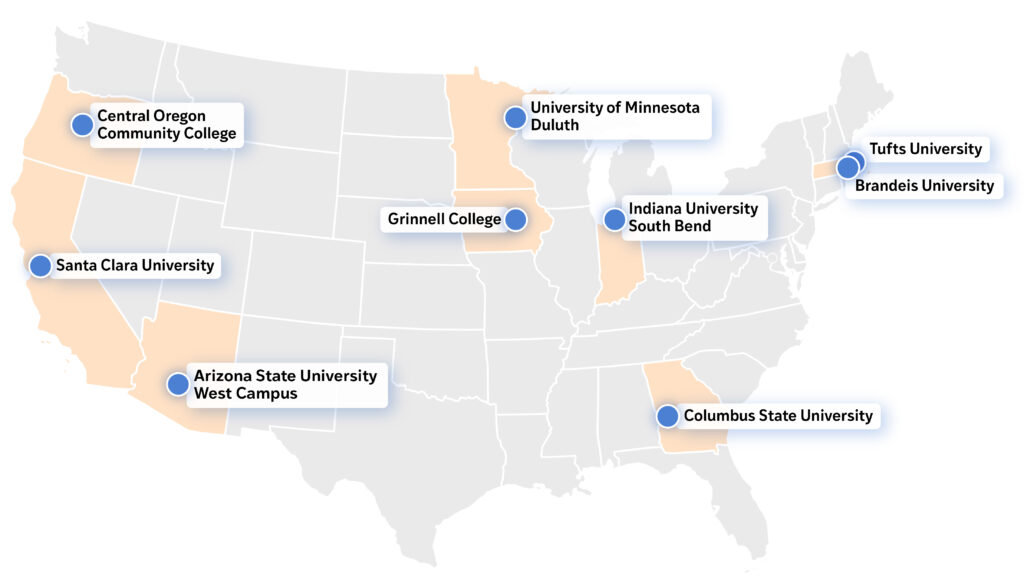Frequently Asked Questions
PIL Climate Study
June 26, 2023 – June 19, 2024

What is PIL’s climate study about?
What are information worlds? How can they help us understand climate awareness in a divided America?
How does PIL’s study differ from other studies on climate change awareness?
Are college students included in this study?
Isn’t PIL’s research usually focused on college students?
How will you conduct the study?
How will you get your sample for the general public survey?
What kinds of questions will you ask?
What will this new research tell us that we may not already know?
How do you expect your findings to be used?
How will the research be shared?
Who’s working on this study?
What is Project Information Literacy (PIL)?
What is PIL’s climate study about?
The climate emergency demands immediate and collective action. To promote a shared understanding of the crisis more effectively, educators, librarians, journalists, climate stewards, policymakers, and concerned citizens need to know how a divided America views climate change and either takes action or does not. During 2023/2024, we are therefore conducting a large-scale survey of U.S. residents between 16 and 85 years old to delve into how their encounters with climate change news and information—and the behaviors that manage those encounters—shape Americans’ disparate responses to the worldwide climate crisis. A final open-access report with our findings will be published in June 2024.
What are information worlds? How can they help us understand climate awareness in a divided America?
Our study is the first to be grounded in information worlds: the collective arrangements of personalized news, information technologies, and social spaces through which people encounter and process information about the world around them. We are currently in Phase Three of the our study and using our survey data to map the shape and ideological terrain of information worlds in a U.S. that is divided in its awareness of, attitudes to, and acceptance of climate change as a scientific fact.
How does PIL’s study differ from other studies on climate change awareness?
Our study asks not what people in the U.S. know about climate change, but how they know it. By leveraging our combined domain expertise in information science, data science, information literacy, and new media research, we are modeling the mechanisms by which people in America encounter information about the climate crisis and, in turn, how these mechanisms contribute to their attitudes to climate change.
Are college students included in this study?
Yes. In addition to surveying a cross-section of U.S. residents, we are surveying college students enrolled at nine institutions in different parts of the country: Arizona State University West Campus, Brandeis University, Central Oregon Community College, Columbus State University, Grinnell College, Indiana University South Bend, Santa Clara University, Tufts University, and University of Minnesota Duluth. Segmenting our sample to include students allows us to explore the degree to which young adults are being prepared to effect change about the climate crisis amid hope, despair, and envisioning their own role in the future of the planet.

Isn’t PIL’s research usually focused on college students?
Yes. In this study, we are building on 15 years of PIL research about the information practices of college students to begin a new chapter at the PIL research institute. We are interested in studying how flows of information in a very diverse information landscape impact lifelong and lifewide learning across adults who attended college and those who did not. By comparing the general public to college students, we can explore new questions: What do we know about the terrain of Americans’ information worlds? Are there differences between the shape of the information worlds of the general public and those of university students? What might this comparison tell us about effective strategies for climate advocacy and action? How does the composition of individual information spaces vary among self-described conservatives, liberals, and everyone in between, especially in terms of their attitudes toward climate change?
How will you conduct the study?
Two online surveys were administered to a large sample of people living in the U.S. In fall 2023, we sent the online survey to a random sample of members of the general public to collect data about U.S. residents’ information practices and attitudes across a broad range of demographics. We sent the same survey during winter 2024 to a sample of college students. Our total sample from both of these sources was 6,096 responses, based completed surveys, not partially filled out submissions. By comparing the two sets of responses, we will have richer information about how attitudes and behaviors around climate change vary across demographics and education levels.
How will you get your sample for the general public survey?
We contracted with Qualtrics, a web-based tool used at many universities for creating and distributing surveys, to curate a random sample of general public survey respondents for the PIL Climate Study. We segmented our sample by factors like college vs. no college attendance, geographic residency, and political affiliation.
What kinds of questions will you ask?
We have asked survey respondents how they find news and information about climate change and, conversely, how news and information finds them through technology-mediated channels. We collected data about different climate change information flows that are shaped by a combination of social media feeds, news sources, and information acquired through their cultural and social encounters. Overall, our survey collected data about how subjects develop their understanding of climate change. Our study uses the lens of information literacy, a field framing our team’s own thinking about how trust, agency, curiosity, hope, and social and technological factors contribute to creating our understanding of the world in the digital age.
What will this new research tell us that we may not already know?
Despite increasing media coverage, little research has examined the ways Americans encounter and respond to information about climate change and what factors influence their understanding of the current climate crisis. Our study fills this research gap by collecting data about climate change awareness and attitudes among a sample of American adults as well as their encounters with the variety of information flows that make up their information worlds.
How do you expect your findings to be used?
Our findings will inform the development of climate policy, course curricula and climate steward training programs, media coverage, and community response at a time when collective action on the future of the planet is urgently needed. The promotion and dissemination of deliverables will be enhanced by the project’s affiliated supporter, The National Resource Defense Council (NRDC), one of the oldest nonpartisan, nonprofit environmental advocacy group in the U.S., which has an international membership of three million.
How will the research be shared?
A freely available open access report will be shared on the Project Information Literacy (PIL) website in June 2024. We will also share our research in op-eds, essays, and podcasts for a variety of audiences in media, climate policy, and education. If you would like to join our mailing list, let us know at projectinfolit@pilresearch.org.in.
Who’s working on this study?
Dr. Alison J. Head, PIL’s Founder and Director, is the PIL Climate Study’s Principal Investigator. She is joined by PIL co-researchers: Steven Geofrey, Senior Research Scientist; Barbara Fister, PIL Inaugural Scholar in Residence; and Research Analysts, Dr. Kirsten Hostetler (Central Oregon Community College) and Alaina Bull (University of Washington Tacoma).
What is Project Information Literacy (PIL)?
PIL, established in 2008, is a nonprofit research institute in the San Francisco Bay Area. We work in small teams on large, national research projects. For the PIL College Study, we used social science and data science methods to survey and interview nearly 21,000 college students in the U.S., releasing 12 groundbreaking reports, examining how American college students interact with information resources for school, for life, for work, and most recently, for engaging with the news and algorithms. You can learn more about PIL at https://projectinfolit.org.
